Camp Fire Yarn No. 12
SPOORING
Men's Tracks • Animals' Tracks • The Age of Tracks • Hints on "Spooring"
General Dodge, of the American Army, described how he once had to pursue a party of Red
Indians who had murdered some people.
The murderers had nearly a week's start, and had gone away on horseback. Except for one,
they were all riding unshod horses.
General Dodge got a splendid tracking-scout named Espinosa to help him. After tracking
the Indians for many miles, Espinosa suddenly got off his horse and pulled four horseshose out of a hidden crevice in the
rocks. The rider of the shod horse had evidently pulled them off so that they should not leave a track.
For six days Dodge and his men pursued the band, and for a great part of the time there
was no sign visible to an ordinary eye. After going for 150 miles they eventually overtook and captured the whole party. It
was entirely due to Espinosa's good tracking.
TRACKING BY NIGHT
On another occasion some American troops were following up a number of Red Indians, who
had been raiding and murdering whites. They had some other Red Indian scouts to assist them in tracking.
In order to make a successful attack, the troops marched by night, and the trackers found
the way in the darkness by feeling the tracks of the enemy with their fingers. They led on at a fairly good pace for many
miles; but suddenly they halted and reported that the track they had been following had been crossed by a fresh track. When
the commanding officer came up, he found the Indians still holding the track with their hands, so that there should be no
mistake.
A light was brought and it was found that the new track was that of a bear which had walked
across the trail of the enemy! The march continued without further incident, and the enemy was surprised and caught in the
early hours of the morning.
The American Scout, Frederick Burnham, who was with Wilson's men in South Africa when
they were massacred on the Shangani River in Matabeleland, was sent away with a dispatch shortly before they were surrounded.
He traveled during the night to escape the observation of the enemy. He found his way by feeling for the tracks left in the
mud by the column when it marched up there in the morning
I myself led a column through an intricate part of the Matopo Hills in Rhodesia by night
to attack the enemy's stronghold which I had reconnoitred the previous day. I found the way by feeling my own tracks, sometimes
with my hands and sometimes through the soles of my shoes, which had worn very thin. I never had any difficulty in finding
the line.
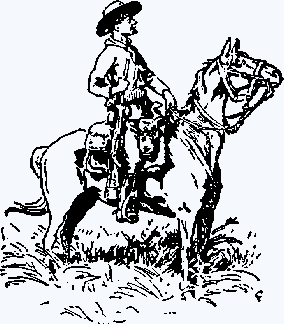
THE IMPORTANCE OF TRACKING
Tracking, or following up tracks, is called by different names in different countries.
Thus, in South Africa, you would talk only of "spooring", that is, following up the "spoor"; in India, it would be following
the "pugs", or "pugging"; in North America, it is also called "trailing".
It is one of the principal ways by which Scouts gain information and hunters find their
game. But to become a good tracker you must begin young and practise it at all times when you are out walking, whether in
town or country.
If at first you constantly remind yourself to do it, you will soon find that you do it
as a habit without having to remind yourself. It is a very useful habit, and makes the dullest walk interesting.
Hunters when they are looking about in a country to find game first look for any tracks,
old or new, to see if there are any animals in the country. Then they study the newer marks to find out where the animals
are hiding themselves. Then, after they have found a fresh track, they follow it up till they find the animal and kill it.
Afterwards they often have to retrace their own tracks to find their way back to camp. War scouts do much the same as regards
their enemies.
MEN'S TRACKS
First of all you must be able to distinguish one man's footmark from that of another,
by its size, shape, and nails, etc. And, similarly, the prints of horses and other animals.
From a man's track, that is, from the size of his foot and the length of his stride, you
can tell, to a certain extent, his height.
In taking notes of a track you should pick out a well-marked print, very carefully measure
its length, length of heel, width of sole, width at instep, width of heel, number of rows of nails, and number of nails in
each row, heel and toe-plates or nails, shape of nail-heads, nails missing, etc.
It is best to make a diagram of the foot-print thus. You should also measure very carefully
the length of the man's step from the heel of one foot to the heel of the other.

A man was once found drowned in a river. It was supposed that he must have fallen in accidentally,
and that the cuts on his head were caused by stones, etc., in the river. But someone took a drawing of his boots, and after
searching the river-bank came on his tracks, and followed them up to a spot where there had evidently been a struggle: the
ground was much trampled and bushes broken down to the water's edge, and there were tracks of two other men's feet. Though
these men were never found, it showed the case to be one of probable murder, which would not otherwise have been suspected.
Differences Between Bare-Foot Tracks
It is very puzzling for a beginner to tell the difference between a lot of footmarks of
bare feet-they all look so much alike-but this is the way that the Indian police trackers do it.
When measuring the footprint of the man you are after draw a line from the tip of the
big toe to the tip of the little toe, and then notice where the other toes come with regard to this line, and put it down
in your note-book. Then when you come to a number of tracks you have only to try this same line on one or two of them till
you find the one you want. All people vary a little in the position of then-toes.
Try it with the other Scouts in your Patrol, each of you making a footprint with his bare
foot, and then noting how it is different from the others when the toe line is drawn.
THE PACE OF TRACKS
A Scout must learn to recognize at a glance at what pace the maker of the tracks was going.
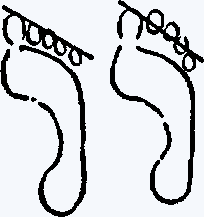
A man walking puts the whole flat of his foot on the ground, each foot a little under
a yard from the other. In running, the toes are more deeply dug into the ground, and a little dirt is kicked up, and the feet
are more than a yard apart. Sometimes men walk backwards in order to deceive anyone who may be tracking, but a good Scout
can generally tell this at once by the stride being shorter, the toes more turned in, and the heel marks deeper.
HORSES' TRACKS
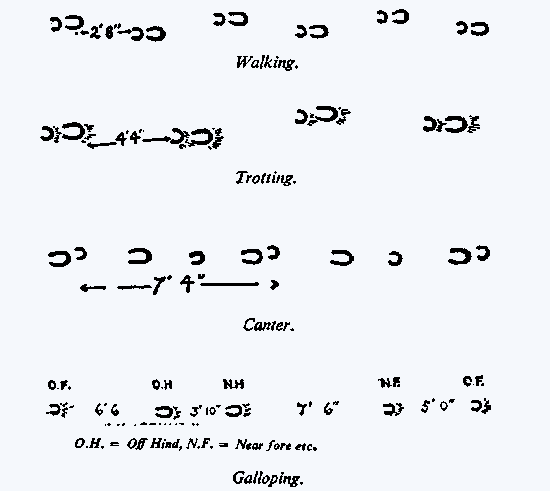
With animals, if they are moving fast, their toes are more deeply dug into the ground,
and they kick up the dirt, and their paces are longer than when going slowly.
You ought to be able to tell the pace at which a horse has been going directly you see
the tracks.
At a walk the horse makes two pairs of hoof prints-the near (left) hind foot close in
front of near fore foot mark, and the off (right) fore foot similarly just behind the print of the off hind foot. At a trot
the track is similar, but the stride is longer.
The hind feet are generally longer and narrower in shape than the fore feet.
It was a trick with highwaymen of old, and with horse stealers, to put their horses' shoes
on the wrong way round in order to deceive trackers who might try to follow them up. But a good tracker would not be taken
in. Similarly, thieves often walk backwards for the same reason, but a clever tracker will very soon recognize the deception.
Wheel tracks should also be studied till you can tell the difference between the tracks
of motor-cars or bicycles, and the direction they were going.
THE AGE OF TRACKS
In addition to learning to recognize the pace of tracks, you must get to know how old
they are. This is a most important point, and requires a very great amount of practice and experience before you can judge
it really well.
So much depends on the state of the ground and weather, and its effects on the "spoor".
If you follow one track, say, on a dry, windy day, over varying ground, you will find that when it is on light, sandy soil,
it will look old in a very short time, because any damp earth

that it may kick up from under the surface will dry very rapidly to the same colour as
the surface dust, and the sharp edges of the footmarks will soon be rounded off by the breeze playing over the dry dust in
which they are formed. When it gets into damp ground, the same track will look much fresher, because the sun will have only
partially dried up the upturned soil, and the wind will not, therefore, have bevelled off the sharp edges of the impression.
If it gets into damp clay, under shade of trees, etc., where the sun does not get at it, the same track, which may have looked
a day old in the sand, will here look quite fresh.
Of course, a great clue to the age of tracks will often be found in spots of rain having
fallen on them since they were made (if you know at what time the rain fell), dust or grass seeds blown into them (if you
noticed at what time the wind was blowing), or the crossing of other tracks over the original ones, or, where the grass has
been trodden down, the extent to which it has since dried or withered. In following a horse, the length of time since it passed
can also be judged by the freshness, or otherwise, of the droppings, due allowance being made for the effect of sun, rain,
or birds, upon them.
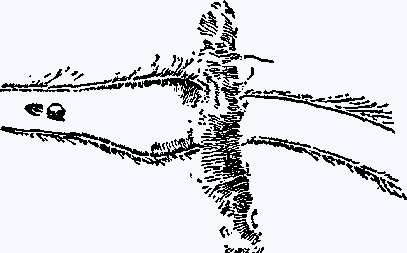
Having learned to distinguish the pace and age of spoor, you must next learn to follow
it over all kinds of ground. This is an accomplishment that you can practise all your life, and will still find yourself continually
improving.
Then there is a great deal to learn from the ashes of fires-whether they are still warm
or cold, scraps showing what kind of food the people were eating, whether plentiful or scarce.
You must not only keep a sharp lookout for Scout "signs" made by your own Scouts, but
also for those made by "hostile" Scouts.
The following are some of the signs made by tramps on walls or fences near houses where
they have been begging, which they chalk up to warn others of their class:

Very bad: they give you in charge here.

Too many tramps have been here already.

No good.

Bad people.
Tracking for Stolen Goods
There are very good trackers in the Sudan and Egypt, and I saw some of their work there.
The Colonel of the Egyptian Cavalry had had some things stolen out of his house, so a
tracker was sent for from the neighbouring Jaalin tribe.

He soon found the footprints of the thief and followed them a long way out on to the desert,
and found the spot where he had buried the stolen goods. His tracks then came back to the barracks.
So the whole of the regiment was paraded without shoes on, for the tracker to examine.
And at the end, when he had seen every man walk, he said, "No, the thief is not there." Just then the Colonel's servant came
up to him with a message, and the tracker who was standing by, said to the Colonel, "That is the man who buried the stolen
goods."
The servant, surprised at being found out, then confessed that it was he who had stolen
his master's property, thinking that he would be the last man to be suspected.
HINTS ON SPOORING
When getting on to very fresh spoor of man or beast, the old Scout will generally avoid
following it closely, because the hunted animal will frequently look back to see if it is being followed. The tracker therefore
makes a circle, and comes back on to where he would expect to find the spoor again. If he finds it, he makes another circle
farther ahead till he finds no spoor. Then he knows he is ahead of his game, so he gradually circles nearer till he finds
it, taking care, of course, not to get to windward of the animal when within scenting distance.
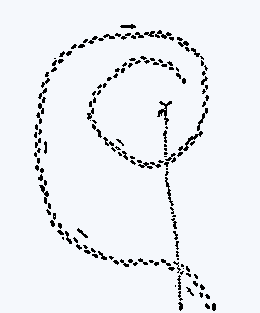
Some trackers of Scinde followed up a stolen camel from Karachi to Sehwan, 150 miles over
sand and bare rock. The thieves, to escape detection, drove the camel up and down a crowded street, in order to get the trail
mixed up with others-but the trackers foresaw this and made a "cast" round the town, and hit on the outgoing spoor on the
far side, which they successfully followed up.
Look Ahead Over Hard Ground
In tracking where the spoor is difficult to see, such as on hard ground, or in grass,
note the direction of the last footprint that you can see, and look on in the same direction, but well ahead of you, say 20
or 30 yards. In grass you will then generally see the blades bent or trodden, and on hard ground, possibly stones displaced
or scratched, and so on-small signs which, seen in a line one behind the other, give a kind of track that otherwise would
not be noticed.
I once tracked a bicycle on a hard macadam road where it really made no impression at
all, but by looking along the surface of the road for a long distance ahead of me, under the rising sun as it happened, the
line it had taken was quite visible through the almost invisible coating of dew upon the ground. Standing on the track and
looking upon it close to my feet I could not see the slightest sign of it.
The great thing is to look for a difficult track against the sun, so that the slightest
dent in the ground throws a shadow.
"Casting" for a Lost Track
If you lose sight of the track you must make a "cast" to find it again. To do this put
your handkerchief, staff, or other mark at the last footmark that you noticed, then work round it in a wide circle, say, 30,
50, or 100 yards away from it as a centre-choosing the most favourable ground, soft ground if possible, to find signs of the
outward track. If you are with a Patrol it is generally best for the Patrol to halt while one or perhaps two men make the
cast. If everybody starts trying to find the spoor they very soon defeat their object by treading it out or confusing it with
their own footmarks-too many cooks easily spoil the broth in such a case.
In making a cast, use your common sense as to which direction the enemy has probably taken,
and try it there.
I remember an instance of tracking a boar which illustrates what I mean. The boar had
been running through some muddy inundated fields, and was easy-enough to follow until he turned off over some very hard and
stony ground, where after a little while not a sign of his spoor was to be seen. A cast had accordingly to be made. The last
footmark was marked, and the tracker moved round a wide circle, examining the ground most carefully, but not a sign was found.
Then the tracker took a look round the country, and, putting himself in place of the pig, said "Now in which direction would
I have gone?" Some distance to the front of him, as the original track led, stood a long hedge of prickly cactus; in it were
two gaps. The tracker went to one of these as being the line the boar would probably take, Here the ground was still very
hard, and no footmark was visible, but on a leaf of the cactus in the gap was a pellet of wet mud; and this gave the desired
clue. There was no mud on this hard ground, but the pig had evidently brought some on his feet from the wet ground he had
been travelling through. This one little sign enabled the tracker to work on in the right direction to another and another,
until eventually he got on to the spoor again in favourable ground, and was able to follow up the boar to his resting-place.
Fitting Your Stride to the Track
I have watched a tracker in the Sudan following tracks where for a time they were quite-
invisible to the ordinary eye in this way. While the track was clear he made his own stride exactly to fit that of the track,
so that he walked step for step with it, and he tapped the ground with his staff as he walked along-ticking off each footprint,
as it were. When the footprints disappeared on hard ground, or had been buried by drifting sand, he still walked on at the
same pace, tap-tapping the ground with his staff at the spot where there ought to have been a footprint. Occasionally he saw
a slight depression or mark, which showed that there had been a footprint there, and thus he knew he was still on the right
line.

PATROL PRACTICES IN SPOORING
Prepare a tracking ground by picking a piece of soft ground, about ten to fifteen yards
square, and making it quite smooth with a roller by sweeping it over. Part of the ground should be wet as if by rain, the
other part dry. Make one boy walk across it, then run, then bicycle. Explain the difference in the tracks, so that the Scouts
of the Patrol can tell at once from any tracks they may see afterwards whether a person was walking or running.
Send out a boy to make tracks and let the Patrol track him and notice when any other tracks
override his, showing what people or animals have passed since. The boy may wear tracking irons strapped to the soles of his
boots. Or he may have a few nails hammered into the sole or into the butt of his staff in a pattern that will make an unmistakable
track.
Study the age of tracks by making fresh tracks a day later alongside the old. Notice the
difference in appearance, so that the Scouts can learn to judge the age of tracks.
Make each' Scout make a track of his shoe in soft ground and draw a diagram of it on paper.
Send Patrols along different roads, and let them return with reports on tracks seen whether
of people, or vehicles or animals.
Make plaster casts of tracks. Build a wall round the track, of mud. Pour water into a
mug or cup, slowly add plaster of Paris, stir all the time, until it is like very thick cream-just pourable. Then pour into
track. When almost dry, scratch on date, where found, etc. When absolutely dry, dig out carefully and wash.
GAMES IN SPOORING
Track Memory
Make a Patrol sit with their feet up, so that other Scouts can study them. Give the Scouts,
say, three minutes to study the shoes. Then leaving the Scouts in a room or out of sight, let one of the Patrol make some
footmarks in a good bit of ground. Call up the Scouts one by one and let each see the track and say who made it.
Track Drawing
Take out a Patrol; set it on to a foot track. See which Scout can make the most accurate
drawing of one of the footprints of the track. The Scouts should be allowed to follow up the track till they get to a bit
of ground where a good impression of it can be found.
Spot the Thief
Get a stranger to make a track unseen by the Scouts. The Scouts study his track so as
to know it again.
Then put the stranger among eight or ten others and let them all make their tracks for
the boys to see, going by in rotation. Each Scout then in turn whispers to the umpire which man made the original track-describing
him by his number in filing past. The Scout who answers correctly wins. If more than one answers correctly, the one who then
draws the best diagram of the footprint from memory wins.
Follow the Trail
Send out a "hare", either walking or cycling, with a pocketful of chicken feed, nutshells,
confetti paper, etc., dropping a little here and there to give a trail for the Patrol to follow.
Or use Scout signs, scratched in the ground or formed from twigs, hiding a letter at some
point.

